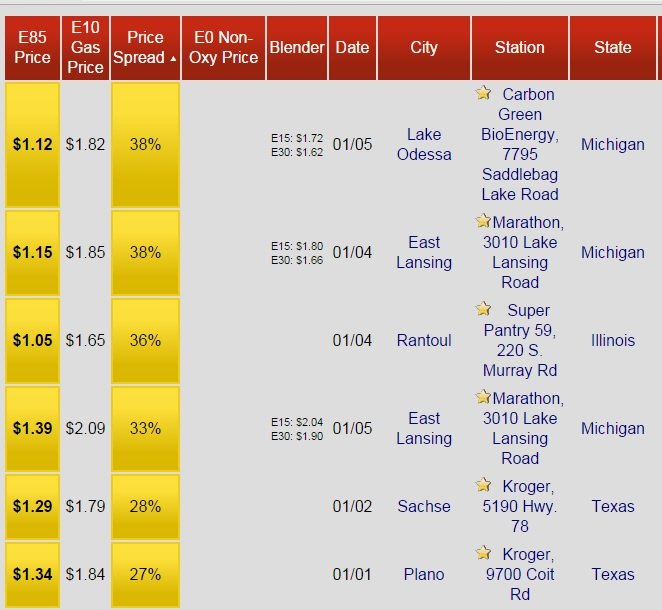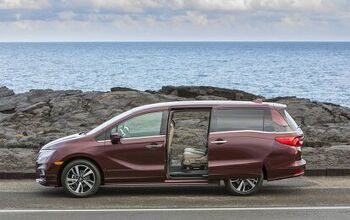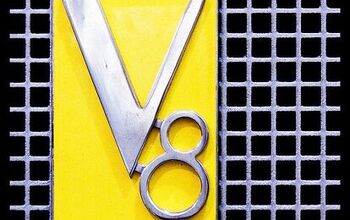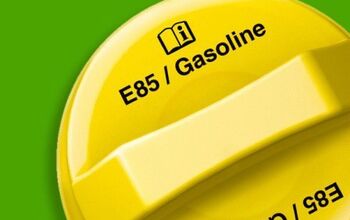Is This E85's Time To Shine?

The recent fall in fuel prices isn’t just an opportunity for Americans to demonstrate their collective inability to remember the events of even the recent past; it’s also a decisive hammerblow to E85 plants and retailers across the country.
This has to be the case, right?
Well, it’s certainly the tack that the media has been taking over the past month, with most media outlets reporting significant drops in E85 consumption as “natural gasoline” falls below the $2 mark in many markets. Certainly, gasoline is lower in terms of inflation-adjusted pricing than it’s been in decades. I filled up my Accord the other day from below the “E” mark for a price of $30.20, obtaining 421 mixed-use miles from the resulting fillup. Each mile is costing me about six cents in fuel, compared to the approximately twenty cents per mile I paid to operate my Town Car eighteen months ago.
As fate would have it, however, the very thing that causes opponents of E85 to decry its assistance is allowing it to deliver some fairly staggering pricing. The “consensus opinion” is that a gallon of petroleum energy creates between 1.24 and 1.6 gallons of corn-based E85. Other base crops like sugar cane and switchgrass can offer much higher yields, but fundamentally when we think “ethanol” in the United States we think about corn-based ethanol. When the cost of petroleum drops, therefore, it has a massive effect of the cost of ethanol production.
Long-time TTAC readers will remember that I ran my now-deceased Town Car on E85 for some time and observed lower fuel economy, some stumbling, and skanky behavior as a result. At the time, E85 was $2.29 and gasoline was $2.79, numbers that didn’t quite work for E85.
What about $1.19 vs. $1.89? That’s a much bigger (62% vs. 82%) gap, and it’s courtesy of Michigan’s Yellow Hose Program. Gasoline hasn’t been that cheap since before Nixon. Seeing $1.19 on a fuel station sign, or even seeing the $1.36 that my local Kroger is asking for E85, is psychologically important, and we’re a country that runs on stuff like that.
I’m not going to fill up my not-quite-Super-Coupe with E85; it’s the one modern Honda that can’t handle the juice even with an adapter. Still, the numbers on E85 are now good enough that municipalities might consider filling their flex-fuel cars from the yellow hose, and corporations might follow. I’m also considering building a NASA race car that runs exclusively on E85. If I do that, look for future E85 reports from this writer to have much more factual data and much less descriptions of vodka spilled between someone’s legs, okay?

More by Jack Baruth
Latest Car Reviews
Read moreLatest Product Reviews
Read moreRecent Comments
- Buickman I like it!
- JMII Hyundai Santa Cruz, which doesn't do "truck" things as well as the Maverick does.How so? I see this repeated often with no reference to exactly what it does better.As a Santa Cruz owner the only things the Mav does better is price on lower trims and fuel economy with the hybrid. The Mav's bed is a bit bigger but only when the SC has the roll-top bed cover, without this they are the same size. The Mav has an off road package and a towing package the SC lacks but these are just some parts differences. And even with the tow package the Hyundai is rated to tow 1,000lbs more then the Ford. The SC now has XRT trim that beefs up the looks if your into the off-roader vibe. As both vehicles are soft-roaders neither are rock crawling just because of some extra bits Ford tacked on.I'm still loving my SC (at 9k in mileage). I don't see any advantages to the Ford when you are looking at the medium to top end trims of both vehicles. If you want to save money and gas then the Ford becomes the right choice. You will get a cheaper interior but many are fine with this, especially if don't like the all touch controls on the SC. However this has been changed in the '25 models in which buttons and knobs have returned.
- Analoggrotto I'd feel proper silly staring at an LCD pretending to be real gauges.
- Gray gm should hang their wimpy logo on a strip mall next to Saul Goodman's office.
- 1995 SC No


































Comments
Join the conversation
I think CNG powered vehicles in many cases would make more sense than gasoline or E85; the infrastructures in most cities are not quite there yet but with some work they could be. All of the city busses in San Diego run CNG and there are several fueling stations open to the public around the metro area. Still, "several" doesn't quite cut it for a metro area with several million people living/working there (the census numbers might say a lower number, but it's northern Tijuana). Here in OKC, there seems to be a few more public CNG stations available. I don't believe these current gas prices will last long, and when they shoot back up next time there's some overseas political issue, CNG will go back to being cheaper.
I'm currently driving a 2011 Fusion with the 2.5 4 cylinder. Open the fuel door, and there is a notice around the filler that reads "E85" surrounded by a "NO" symbol. I'll follow the manufacturer's advice and avoid it.